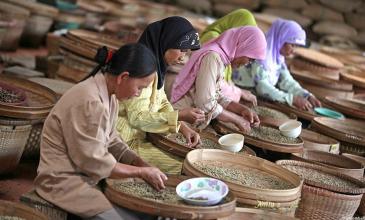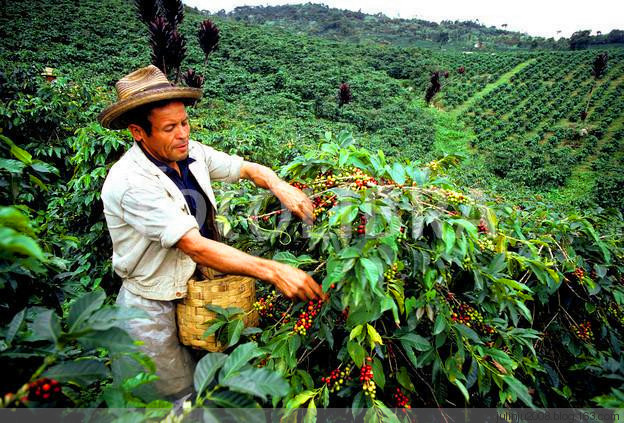How do you cook coffee beans? Santa Rita santa rita, Colombia imports high quality washed coffee beans
Frankly speaking, coffee beans cannot be brewed, and frankly speaking, even though coffee was made many years ago, it was a long story, but a lot of literary or film works always use this verb (of course, not strictly speaking, brewing in a siphon pot is a kind of brewing), and it is brewing coffee beans, which really depressed the editor in the coffee shop for a long time. The editors of some websites solemnly wrote a tutorial on cooking coffee beans, which made me even more ashamed.
All right, enough gossip. Let me talk about making coffee.
First of all, there are two kinds of coffee beans, the ones before baking are called raw beans, which are generally green, some may turn blue according to the different treatment methods, and some may turn white according to the storage time.
Raw coffee beans
The baked beans are called cooked beans, that is, black (or brown) baked beans to varying degrees.
All coffee beans need to be roasted and caramelized before they have the flavor of coffee. No matter how they are brewed (note, it is brewed, not put on the fire and boiled with water), the coffee needs to be ground into powder, which can be ground by hand, or by a professional machine, and then by hand brewing coffee, Italian machine, or siphon pot to make the water pass through the coffee powder. This process is called the liquid obtained by extraction, which is the coffee we drink.
The reason why it can not be brewed is that if you brew it, the caffeine in the coffee will come out to produce bitterness. Here, the weak and weak add that, in fact, normal coffee is not bitter.
The history of coffee cultivation in Colombia can be traced back to the Spanish colonial era in the 16th century, and there are many theories about the history of coffee in Colombia:
One: it is said to come from the sea island of the Caribbean and from El Salvador in Central America.
Second: in 1808, a priest introduced coffee beans to Colombia for the first time from the French Antilles via Venezuela. One of them is that Colombia's first coffee seeds were imported from Venezuela through the province of Santander.
Third: the earliest records of coffee cultivation in Colombia appear in the book "TheIllustratedOrinoca" written by JoseGumilla, a Spanish missionary. He describes what he saw when he preached on both sides of the Meta River in 1730, in which he mentioned the local coffee plantation. By 1787, other missionaries had spread coffee to other parts of Colombia.
Colombia, located in the northwest of South America, is a beautiful country with a long history. Indians have lived on this land since ancient times. It was colonized by Spain in 1531 and gained independence in 1819. It was renamed in 1886 to commemorate Columbus, the discoverer of the American continent. Colombia has beautiful mountains and rivers, beautiful scenery, pleasant climate, spring all year round and fresh air. Colombia is rich in products, especially coffee, flowers, gold and emeralds are known as the "four treasures". Today, the country is the second largest coffee producer after Brazil, the world's largest exporter of Arabica coffee beans and the world's largest exporter of washed coffee beans. Colombian coffee is often described as silky and smooth. Of all the coffees, it is the most balanced, soft, smooth and ready to drink, and it has won praise that no other coffee can match: known as "green gold".
Country: Colombia
Producing area: Antioquia province
Altitude: 1600-2100 m
Treatment: washing
Variety: Kaduai, Kaddura
Manor: Santa Rita
Flavor: sucrose, clean, medium alcohol thickness

Important Notice :
前街咖啡 FrontStreet Coffee has moved to new addredd:
FrontStreet Coffee Address: 315,Donghua East Road,GuangZhou
Tel:020 38364473
- Prev

American boutique manor hope manor honey to treat rare variety Mocha bean Colombia triple crown king ripe
The variety of mocha round beans can be said to be the pearl treasure of the coffee industry. ElInjerto Manor in Guatemala has become a hit since it was sold at an online auction for $211.5 a pound in 2011, and at a crazy price of $500.5 a pound in 2012, the market has remained high-end in recent years, such as $321.51 a pound in 2014. after all, it is still a rare species.
- Next

How to use ear bag to make Coffee step Coffee Machine on the way to Rose Summer
The portable earbag is a patented design developed by the Japanese, in which the coffee powder is packed in a filter bag, and the splints made of cardboard on both sides can be hung on the cup and thrown away after rinsing, so that it is convenient to drink ground coffee like filter droplets. Hanging ear bag Coffee is a ready-to-enjoy freshly ground coffee. The coffee is brewed by drip filtration, and the sour, sweet, bitter, mellow and fragrant coffee
Related
- Does Rose Summer choose Blue, Green or Red? Detailed explanation of Rose Summer Coffee plots and Classification in Panamanian Jade Manor
- What is the difference between the origin, producing area, processing plant, cooperative and manor of coffee beans?
- How fine does the espresso powder fit? how to grind the espresso?
- Sca coffee roasting degree color card coffee roasting degree 8 roasting color values what do you mean?
- The practice of lattes: how to make lattes at home
- Introduction to Indonesian Fine Coffee beans-- Java Coffee producing area of Indonesian Arabica Coffee
- How much will the flavor of light and medium roasted rose summer be expressed? What baking level is rose summer suitable for?
- Introduction to the characteristics of washing, sun-drying or wet-planing coffee commonly used in Mantenin, Indonesia
- Price characteristics of Arabica Coffee Bean Starbucks introduction to Manning Coffee Bean Taste producing area Variety Manor
- What is the authentic Yega flavor? What are the flavor characteristics of the really excellent Yejasuffi coffee beans?

